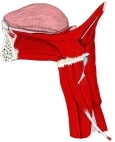肩甲舌骨筋 ( けんこうぜっこつきん、 英 : omohyoid muscle )
・ 概 要 |
・ 作 用 |
・ イラスト掲載サイ |
|
・ イラスト |
・ 神経 / 脈管 |
||
・ 起始 / 停止 |
・ Wikipedia |


![]()
・ 「 この筋は胸骨舌骨筋と同じ層にある。」 ( 日本人体解剖学 )
以下は「 日本人体解剖学 」の一部となる。
「 肩甲舌骨筋は、胸鎖乳突筋と交叉するため、そお上方すなわち上腹との間に頚動脈三角( その底を頸動脈窩という )、その下方すなわち下腹との間に肩甲鎖骨三角(その底を大鎖骨上窩という)をつくる。」
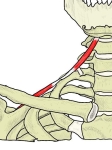 |
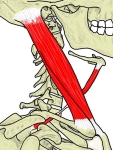 |
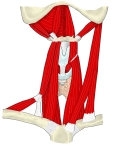 |
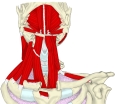 |
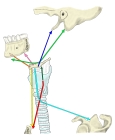 |
|
第6頚椎の高さ |
【 起 始 】: 下 腹 ) 上肩甲横靭帯、 肩甲骨 ( 上縁および烏口突起 )
※ 起始部より斜め上内側方に走って 中間腱 に移行し上腹となって弓状に上方に走る。
【 停 止 】: 上 腹 ) 舌骨体 ( 下縁 )
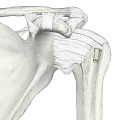 |
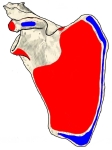
右肩甲骨(前面) |

|
「 舌骨を後下方に引き、同時に頚筋膜を張る。 」 ( 日本人体解剖学 )
・ 神 経 : 頚神経ワナ の 上根 ( C1~C3 ) ※ 「 日本人体解剖学 」
※ 資料によっては(C2,C3)としているものも見られる。
・ 動 脈 :
・ 静 脈 :
The omohyoid muscle is a muscle that depresses the hyoid. It is located at the front of the neck and consists of two bellies separated by an intermediate tendon. Its superior belly serves as the most lateral member of the infrahyoid muscles, located lateral to both the sternothyroid and thyrohyoid muscles.[1] Its name derives from the Greek "omos" meaning shoulder, giving one of its attachments, and "hyoid", giving the other attachment - the hyoid bone.
【 Structure 】
It arises from the upper border of the scapula, and occasionally from the superior transverse scapular ligament which crosses the scapular notch, its extent of attachment to the scapula varying from a few millimetres to 2.5 cm.
This muscle has two separate bellies : superior and inferior.[1]
From this origin, the inferior belly forms a flat, narrow fasciculus, which inclines forward and slightly upward across the lower part of the neck, being bound down to the clavicle by a fibrous expansion ; it then passes behind the sternocleidomastoid, becomes tendinous and changes its direction, forming an obtuse angle.
It ends in the superior belly, which passes almost vertically upward, close to the lateral border of the sternohyoid, to be inserted into the lower border of the body of the hyoid bone, lateral to the insertion of the sternohyoid.
The central tendon of this muscle varies much in length and form, and is held in position by a process of the deep cervical fascia, which sheaths it, and is prolonged down to be attached to the clavicle and first rib; it is by this means that the angular form of the muscle is maintained. The tendon overlies the internal jugular vein, and can be used as a landmark for this vein during surgery.
【 Variations 】
Doubling ; absence ; origin from clavicle ; absence or doubling of either belly.
【 語 句 】
・ hyoid : 舌骨 ・ intermediate tendon : 中間腱 ・ infrahyoid muscles : 舌骨下筋 ・ sternothyroid muscle : 胸骨甲状筋 ・ thyrohyoid muscle : 甲状舌骨筋 ・ scapula : 肩甲骨 ・ superior transverse scapular ligament : 上肩甲横靭帯 ・ scapular notch : 肩甲切痕 ・ vary : 様にする ・ fasciculus : 束 ・ sternocleidomastoid : 胸鎖乳突筋 ・ obtuse angle : 鈍角 ・ deep cervical fascia : 深頚筋膜 ・ angular : 角のある ・ internal jugular vein : 内頸静脈




